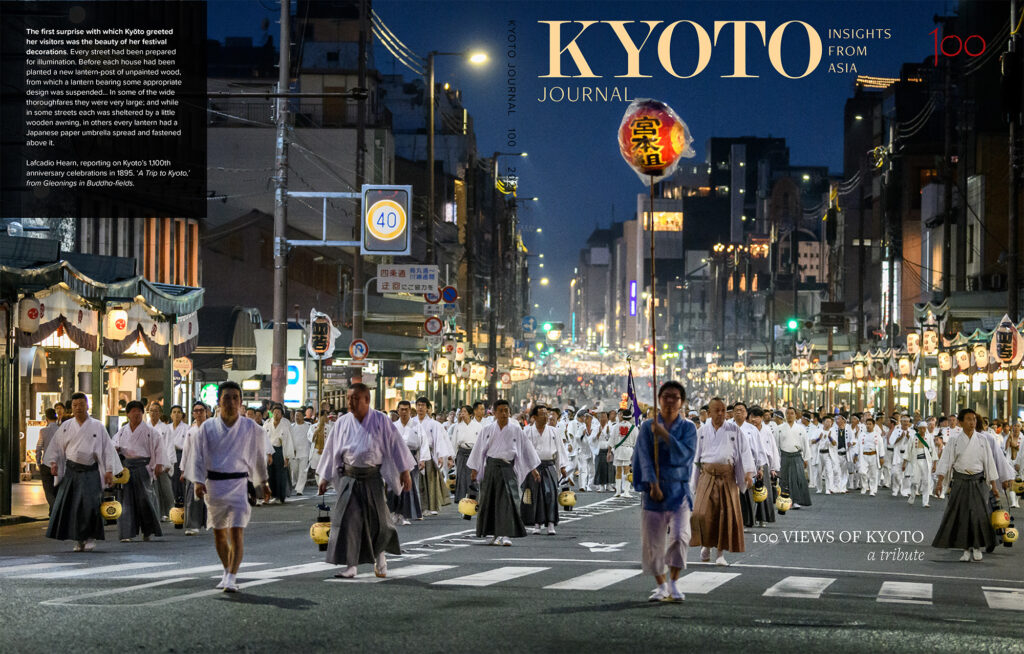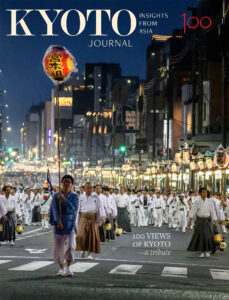Kyoto Journal 100th Issue Published
Review by Rebecca Otowa Sept. 24, 2021
This month, throughout Japan and the world of people who love Japan, a great sigh of relief and satisfaction could be felt. The 100th issue of the prestigious Kyoto Journal was published.
Since it first saw the light in 1987, this quarterly publication has had many printing vicissitudes, and twice has had to go to online publishing due to cost considerations. But thanks to many generous donations, and to the SunM printing company, this 100th issue has been lavishly and beautifully printed and can be held in the hand. Devoted readers will surely raise a cheer.
Kyoto Journal and Writers in Kyoto have gone hand in hand for years, although KJ is much more venerable; we are both volunteer organizations. We can count several key members of the KJ editing and publishing team among our members, including John Einarsen and Ken Rodgers. In addition, this 100th issue contains many pieces by respected voices of the Kyoto foreign community who are also members of WiK, including John Dougill, Alex Kerr, Robert Yellin, Felicity Tillack, Mark Hovane, Catherine Pawasarat, Edward J. Taylor, and many more.
Spoiler alert! Herewith a few highlights from members’ contributions. John Dougill’s piece, View 2 “Dimensions”, describes the various facets of Kyoto, from the physical buildings to educational institutions, craft traditions and tourism, finally touching on the “unseen” city with all its historical milestones and panoramas. Robert Yellin contributes information about some of Kyoto’s contemporary potters in View 28, “Clay Play”. And Mark Hovane, expert on gardens, introduces a wonderful Japanese phrase that he learned while walking through Honen’in soon after he arrived, in View 59 “Komorebi”, the beauty of dappled sunlight through the trees.
This issue includes articles from past Journals, as well as photography, poetry, and essays on every conceivable topic from “Heian Era” (View 3) to “Intoxication” (View 72) and “Pokemon” (View 39). Each View is accompanied by a cute stylized logo designed by Hirisha Mehta. Due to space considerations, this print version ends at “An Astonishing Amalgam” (View 82); the remaining 18 Views will be available to read on the KJ website. Each View shows a different aspect, and they are all imbued with the love that each individual has grown to feel for the fair city of Kyoto. The pieces are short and easy to read, and the visual content as always is superb, highlighting the talents of both illustrators and photographers.
If I may be permitted a small personal reminiscence, years ago I was pleased to appear as an extra in the film “Chikyu no Heso” (The Navel of the World, 2008), in which (in a not too far distant future) Kyoto’s traditions have been taken over by the people who love them most, the foreign residents. I had to wear a Japanese style white apron and pray at a roadside shrine; my little role was of a neighbor lady who was “more Japanese than the Japanese”. There are certainly many foreigners who have made this city their home, and their love of it shines through each page of this beautiful Kyoto Journal. And they may be more deeply responsible for getting the word out about the wonders of the city, particularly in other countries, than the Japanese themselves are.
The cover shows a gathering for purification (Mikoshi-arai) at the end of the Gion Festival, which is very timely, considering the plight of Kyoto with fewer numbers of tourists since the Covid pandemic hit 18 months ago. We at WiK would like to express a heartfelt wish that our beloved city of Kyoto can recover and resume its place among lovers of all things beautiful and evocative in Japan.
*******************
Although the issue has sold out, readers can get a taste of the contents (plus some extras) by looking at this page from the Kyoto Journal website.








Recent Comments